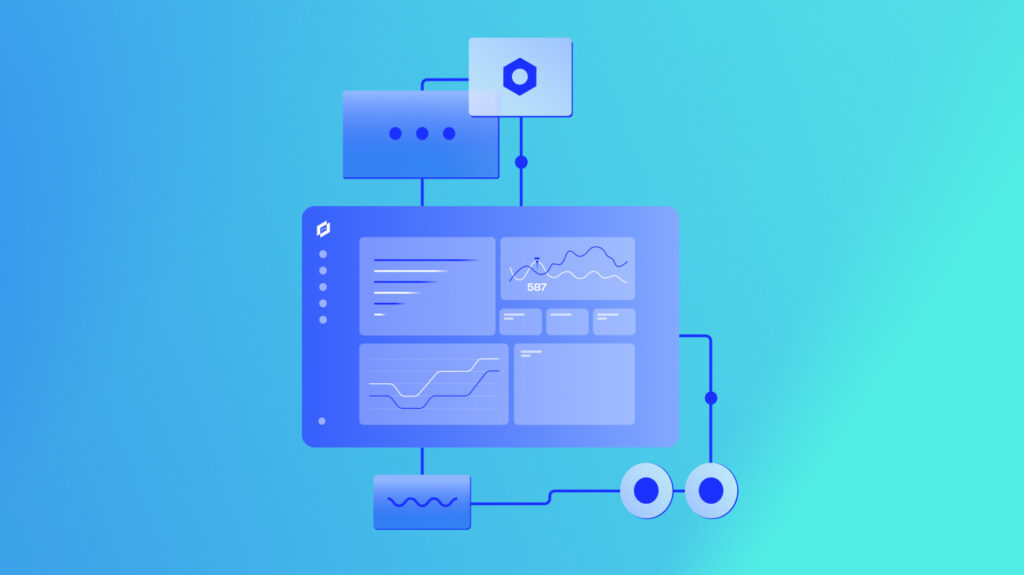Sogeti, a Managed Service Provider (MSP) that provides tech and engineering resources worldwide, had a crucial IT challenge to solve. The MSP operates in more than 100 locations globally and was using six different monitoring tools to monitor its customers’ environments. It was a classic example of tool sprawl and needing to scale where multiple teams of engineers relied on too many disparate tools to manage their customers’ environments. It soon became too arduous for the service provider to collect, integrate, and analyze the data from those tools.
Sogeti had teams of technicians managing different technologies, and they all existed in silos. But what if there was a way to combine those resources?
IT automation provided a solution.
After working with LogicMonitor, Sogeti replaced the bulk of its repeatable internal processes with automated systems and sequences. The result? Now they could continue to scale their business with a view of those processes from a single pane of glass.
Conundrum cracked.
That’s just one example of how IT automation completely revolutionizes how an IT services company like an MSP or DevOps vendor can better execute its day-to-day responsibilities.
By automating repeatable, manual processes, IT enterprises streamline even the most complicated workflows, tasks, and batch processes. There’s no human intervention required. All it takes is the right tech to do it, so IT teams can focus on more strategic, high-priority efforts.
But what exactly is IT automation? How does it work? What are the different types? Why should IT companies even care?
Contents
- IT Automation, Explained
- How Does IT Automation Work?
- Why Do Businesses Use IT Automation?
- The Different Types of IT Automation
- How Can Businesses Use IT Automation?
- IT Automation Pros and Cons
- Will IT Automation Replace Jobs?
- Choosing the Right IT Automation Platform
- Final Word
IT Automation, Explained
IT automation is the creation of repeated software processes to reduce or eliminate manual or human-initiated IT tasks. It allows IT companies with MSPs, DevOps teams, and ITOps teams to automate jobs, save time, and free up resources.
IT automation takes many forms but almost always involves software that triggers a repeated sequence of events to solve common business problems. For example, automating a file transfer so it moves from one system to another with no human intervention. Or auto-generating network performance reports.
Almost all medium and large-sized IT-focused organizations use some automation to facilitate system and software processes, and smaller companies benefit from this tech, too. The most successful ones invest heavily in the latest tools and tech to automate an incredible range of tasks and processes to scale their business. The production, agricultural, and manufacturing sectors were the first industries to adopt IT automation. However, this technology has since extended to niches such as healthcare, finance, retail, marketing, services, and more. Now, IT-orientated companies like MSPs and Enterprise vendors can incorporate automation into their workflows and grow their businesses exponentially.
How Does IT Automation Work?
The software does all the hard work: Clever programs automate tasks that humans don’t have the time or resources to complete themselves.
Developers code these programs to execute a sequence of instructions that trigger specific events from specific systems at specific times. For example, programming software so customer data from a customer relationship management system (CRM) generates a report every morning at 9 a.m. Users of those programs can then customize instructions based on their business requirements.
With so many benefits of IT automation, it’s no wonder that 50 percent of business leaders plan to accelerate the automation of repetitive tasks within their companies.
Why Do Businesses Use IT Automation?
IT-focused businesses use automation for various reasons:
- It makes life easier for tech teams. Engineers and technicians at MSP companies, for example, no longer have to execute tasks like network performance analysis, data security management, or reporting manually. The software takes care of everything for them so they can better focus their efforts on other tasks.
- It makes life easier for non-tech teams. Employees across all departments within an IT-focused organization benefit from automation because they can carry out responsibilities on software and systems with less manual work. For example, administrative employees in a DevOps consulting firm can generate payroll reports without manually entering information into a computer by hand.
- It helps CIOs and executives scale their businesses because other employees like engineers and MSP professionals can complete jobs with minimum effort. Automation frees up tech resources and removes as much manual IT work as possible, allowing IT-centered organizations to improve their margins and grow.
- It helps CIOs and executives fulfill client-orientated objectives by improving service delivery. Automation can also advance productivity across an organization, which results in better service level agreement (SLA) outcomes. Again, the right automation software reduces as much manual work for tech teams as possible, so businesses can grow and carry out responsibilities more efficiently.
- It allows MSPs and other IT companies, especially smaller ones, to survive in ever-competitive environments. By automating processes, these enterprises can stay competitive with more tech resources and reduced manual labor.
- It allows for improved profitability in IT companies. For example, MSPs can onboard more clients without hiring new engineers. That’s because automated systems delegate tasks and resources seamlessly.
- It reduces costs for IT companies by saving time and improving operational efficiencies. By freeing up human resources, for example, enterprises can focus on generating more sales and revenue. As a result, CIOs and executives have more money to spend on labor and can add highly-skilled IT professionals to their tech teams.
Different IT Automation Types
IT companies benefit from various types of IT automation.
Artificial Intelligence
A branch of computer science that is concerned with the development of machines that automate repeatable processes across industries. In an IT-specific context, artificial intelligence (AI) automates repetitive jobs for engineers and IT staff, reduces the human error associated with manual labor, and allows companies to carry out tasks 24 hours a day.
Machine Learning
Machine learning (ML) is a type of AI that uses algorithms and statistics to find real-time trends in data. This intelligence proves valuable for MSPs, DevOps, and ITOps companies. Employees can stay agile and discover context-specific patterns over a wide range of IT environments, whilst significantly reducing the need for case-by-case investigations.
Robot Process Automation
Robot Process Automation (RPA) is a technology that instructs ‘robots’ (machines) to emulate various human actions. Although less common in IT environments than AI and ML, RPA still provides value for MSPs and other professionals. For example, enterprises can use RPA to manage servers, data centers, and other physical infrastructure.
How Can Businesses Use IT Automation?
A proper automation strategy is critical for IT companies. CIOs and executives should decide how to achieve automation within their organizations and then choose the right tools and technologies that facilitate these objectives.
Here are some examples of how IT companies use automation:
Templating/Blueprints
Companies can automate templates and blueprints that promote the successful rollout of services such as network security and data center administration.
Workflow/Technology Integration
Automation allows companies to integrate technology with workflows. As a result, CIOs and executives complete day-to-day tasks more effectively with the latest hardware and software. For example, automating server management to improve service level management workflows, which proves useful if clients expect a particular amount of uptime from an MSP.
AI/ML Integration
AI and ML might be hard for some companies to grasp at first. However, teams can learn these technologies over time and eventually combine them for even more effective automation within their organizations.
Auto-Discovery
Automated applications like the LogicMonitor Collector, which runs on Linux or Windows servers within an organization’s infrastructure, use monitoring protocols to track processes with no manual configuration. Users discover network changes and network asset changes automatically.
Auto-Scaling
IT companies can monitor components like device clusters or a VM in a public cloud and scale resources up or down as necessary.
Automated Remediation/Problem Resolution
Hardware and software can provide companies like MSPs with all kinds of problems (downtime, system errors, security vulnerabilities, alert storms, etc.). Automation, however, identifies and resolves infrastructure and system issues with little or no human effort.
IT Automation Pros and Cons
Here are some pros and cons of automation for those working in IT:
Pros
- Enhanced productivity (improved workflows, higher production rates, better use of technologies and human resources, freeing up of IT resources, etc.).
- Better customer/client outcomes (improved SLAs, faster and more consistent services, higher-quality outputs, enhanced business relationships, etc.).
- Reduced total cost of ownership (auto-discovery tools prevent expensive errors, freeing up of labor resources, automatic discovery of cost-cutting technologies, etc.).
Cons
- Automation requires an initial cost investment as well as an investment of time from engineers to set it up. That’s why it’s a good idea for IT-focused companies to choose a cost-effective automation platform that generates an ongoing return on investment.
- It can be difficult for some team members to adopt automation technologies. Selecting a simplified tool for automation is the best course of action for making the transition easier.
Read more: The Leading Hybrid Observability Powered by AI Platform for MSPs
Will IT Automation Replace Jobs?
There’s a misconception that IT automation will cause job losses. While this might prove true for some sectors such as manufacturing, IT-focused companies have little to worry about. That’s because automation tools don’t work in silos. Skilled IT professionals need to customize automation tools based on organizational requirements and client demands. MSPs that use ML, for example, need to define and determine the algorithms that identify real-time trends in data. ML models might generate data trends automatically, but MSPs still need to select the data sets that feed those models.
Even if automation takes over the responsibilities of a specific team member within an IT organization, executives can upskill or reskill that employee instead of replacing them. According to LogicMonitor’s Future of the MSP Industry Research Report, 96% of MSPs said that investing in automation is worthwhile because it allows IT teams to focus on more strategic tasks and initiatives. By training employees who currently carry out manual tasks, executives can develop a stronger, higher-skilled workforce and still benefit from IT automation.
Choosing the Right IT Automation Platform
Successful data-driven IT teams require technology that scales as their business does and provides CIOs and executives with ongoing value. LogicMonitor is the world’s only cloud-based hybrid infrastructure monitoring platform that automates tasks for IT service companies like MSPs.
LogicMonitor features include:
- An all-in-one monitoring platform that revolutionizes digital transformation for MSPs and DevOps/ITOps teams worldwide.
- Complete 360-degree visibility of utilization, network performance, resource consumption, cloud instances, and much more.
- Full observability of technologies and resources such as servers, data centers, and cloud-based environments.
- The ability to identify problems with legacy tools before they happen.
- Real-time reports and forecasts that reduce internal costs, improve SLA outcomes, and power engineers and other IT professionals.
- No additional hardware maintenance or technical resources. LogicMonitor is ready out-of-the-box.
Take a tour of the platform now.
Final Word
IT automation has revolutionized the IT sector, reducing the manual responsibilities that, for years, have plagued this industry. No longer do MSPs need to enter network performance data into multiple systems or physically inspect servers. Automation does a lot of the hard work so these IT professionals can focus on far more critical tasks. By incorporating a cloud-based infrastructure monitoring platform into their organizations, IT executives improve productivity, enhance workflows, reduce IT resources, promote better client outcomes, and reduce costs over time.
Subscribe to our blog
Get articles like this delivered straight to your inbox








